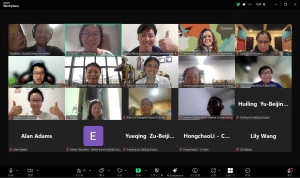Introduction: The terms “social innovation” (shehui chuangxin) and “social management innovation” (shehui guanli chuangxin) have become an important part of the political and public interest discourse in China. This article is less about what China can learn about social innovation from the West, and more about how Chinese academic, media and NGO leaders interpret these terms in the current political climate.
On June 24th, the China Center for Comparative Politics & Economics, the China Social Entrepreneur Foundation (CSEF), and the Social Sciences Academic Press jointly released the “YouChange Social Innovation and Social Enterprise Translations” ((Editor’s Note: YouChange is the English-language brand name of the China Social Entrepreneur Foundation)). Academics from all different backgrounds tried to decipher what “social innovation” and “social enterprise” really means. China Development Brief has summarized their findings below.
This translation is taken from overseas, especially Western developed countries, incorporating new theories and practices about social enterprise and social innovation. The Director of the China Center for Comparative Politics & Economics, Professor Yu Keping (俞可平), gives the report his highest approval. Internationally, innovation has already become a way to solve social problems, and a driving force for positive development. England and its Nonprofit Organizations signing the Compact Agreement, and the Obama Administration’s establishment of the Social Innovation Foundation are both prime examples of governments cooperating with society to encourage innovation. Yu Keping believes that the publication of these translations will help drive social innovation research, growth, and practical application.
Political scientist Yu Keping is widely known for his essay “Democracy is a Good Thing.” In this article, he integrated local realities and democratic values in an effort to interpret and advocate for democracy. Drawing examples from civil society and research papers, and his think-tank background, he was able to let his imagination roam. Focusing on social innovation and civil society and their different sensitivities in China and the West, Yu Keping stresses the importance of avoiding two extremes: “One extreme is as long as it’s from the West, try to imitate it. The other extreme is anything that comes from the West should be contradicted. To study and learn from the Western approach to social innovation and social enterprise can help us to save a great deal of time and resources.”
CSEF’s vice-chair, Tang Min (汤敏), points out that social enterprise is a new concept for social development, and that social innovation needs new methods. In the last ten years or so, social enterprise, social investment and other charitable practices have developed rather quickly. Ever since its conception, CSEF has pushed for new public interest programs that will leave a clear imprint. Supporting the publication of the aforementioned translations is just another way that the Foundation encourages innovative charitable concepts and practices. As Western culture and technology flows to the East, the idea of social innovation has come into the public interest domain.
Society or the Market? A Multi-Dimensional Approach
Regarding the issue of social innovation, those from different backgrounds all have their own views.
Tang, who was former chief economist at the Asian Development Bank, leans towards a market-oriented approach to social innovation. His list of social innovations is filled with successful market examples.
For example, Muhammad Yunus, the founding father of microfinance, established a specialized hospital for performing cataract surgery. Patients are charged according to their financial status, so poor people pay less, or sometimes not at all. After 3-4 years of operation, the hospital is financially stable, and even started making a profit. The ophthalmology hospital was funded by Grameen Bank and the US Agency for International Development (USAID); now it’s operating so well that they have almost repaid their initial investment from USAID. Moreover, Yunus is in the midst of opening similar hospitals for cancer and heart disease.
In order to resolve the issue of child malnutrition, Yunus and Dannon, the Paris-based multinational, have teamed up to create a yogurt company, and are providing nutritious yogurt through Grameen Bank.
In China in 2002, Tang and economist Mao Yushi (茅于轼) jointly established the Fuping Housekeeping School (富平家政学校), which aims to educate rural women and provide them with employment opportunities in cities.
After several years of working with the British Council and the Narada Foundation, CSEF has been conducting training for social entrepreneurs. According to reports, starting this year, they will begin conducting trainings for organizations. CSEF also has two affiliated companies conducting research on giving large-scale loans to microfinance firms. Also, through social investment, they are trying to find ways to connect traditional handicraft markets with urban sales companies. Tang also divulged that CSEF is currently considering starting an incubator for socially-minded companies.
21st Century Business Review chief editor Wu Bofan (吴伯凡) emphasizes the personal pursuit for wealth maximization in business world, taking it a step further to say that public charities should also try to maximize social value. The direction of innovation is to introduce the concept of business wealth management and practice so as to change the inefficiency of non-profit organizations. At this intersection of the public interest and corporate wealth lie exciting opportunities. Social Science Academic Press chief librarian Wang Fei (王绯) believes that the problems of society cannot simply be solved by markets, but that market production theories and methodologies can be used to solve some social issues. The Social Science Academic Press published these translations based off of this type of thinking.
However, just as social innovation is growing and diversifying, the attitudes toward social innovation differ. The China Center for Comparative Politics and Economics assistant director Zhou Hongyun (周红云) puts more emphasis on social mission and social values. She believes that innovation requires cooperation between the three sectors (government, business and nonprofit) and that the solution for social innovation lies at the intersection of these three. “Social enterprise and social innovation are linked, but we can not just interpret it simply as earning money for charity.” said Zhou.
In reality, the development of social enterprise in China has unique qualities and limitations. One example is that many organizations (in China) are not able to register for non-profit status, so they simply register as a business. The foreign concept of social enterprise has, in this way, been introduced into China in a coincidental fashion ((Editor’s Note: The author suggests that a number of Chinese NGOs have coincidentally taken on the form, though not necessarily the function, of social enterprises by registering as businesses as a way to gain legal status)). Since fundraising is so underdeveloped, finding ways to make money on the market has filled the gap, making organizations a little more proactive, with hopes of accomplishing social goals through market mechanisms. But domestic NGOs are facing many challenges in their attempts at marketization. Many of these attempts are raising awareness of social innovation and only provide one of the options for social innovation.
Deciphering Innovation from a Political Perspective
Aside from the discussion and practice of social innovation in the public interest domain, innovation must also be considered from a political perspective. The director of the Tsinghua University NGO Research Center and CPPCC member Wang Ming (王名) advises that we should pay attention to the social innovation signals coming from the government.
Since last year, the central government has repeatedly given such signals. This year, when the Central Party School began its class for provincial party secretaries, three Politburo Standing Committee members talked about social management innovation (shehui guanli chuangxin). The 12th Five Year Plan has five sections on the topic. Corresponding with the idea of bottom-up social innovation, social management innovation has become another major goal for the government ((Editor’s Note: Innovation in social management has been a catchword in the speeches of high leaders such as Hu Jintao for the last few years, and is mentioned frequently in the 12th Five Year Plan (2011-2015). Essentially, it encourages the government at different levels to find innovative ways to address social problems and tensions. There are two parts to this formulation: “innovation” and “social management”. Innovation means using social organizations to help the government provide services and mechanisms for people and communities to resolve their problems. “Social management” though means that social organizations will not work independently, but rather participate in a managed process under the party-state’s supervision.)).
From a macro policy level, Wang Ming divides innovation into three different aspects: the first is finding out the strengths and weaknesses of the system, aiming to break through dual management system which restricts the development of civil society ((Editor’s Note: the dual management system is the current system that requires NGOs to find a professional supervising unit before registering with the Civil Affairs office, thereby submitting to supervision from two government units)) ; the second is to break through the old paradigms of the system, namely traditional non-profit, non-market concepts and mechanisms, to blur the lines between profit and non-profit, market and non-market; the third is to break through traditional economic, political, and social concepts to construct a new civil society.
In the context of contemporary China, Wang Ming takes social management innovation as a political concept, and believes it will predict the path of politics in 2011. Does it stress management or innovation? Is it warning of the pitfalls of civil society, or is it using innovation as a source of reform, to develop civil society with Chinese characteristics? ((Editor’s Note: As stated in an earlier note, there are two parts to “innovation in social management”. One is innovation, which suggests breaking old ways of doing things to develop civil society. The other is social management which stresses using the current system to manage civil society and keep it in a cage. Wang Ming suggests that both interpretations are possible.))
Recently, public opinion surrounding social management innovation has been divided into two distinct camps. Wang Ming stresses that social management innovation means social management reform innovation aimed at reforming the system. This would be the second reform after the market overhaul of the 1980s ((Editor’s Note: Wang Ming is obviously interpreting social management innovation very optimistically to emphasize innovation and reform.))
Tsinghua University Social Studies Professor Shen Yuan (沈原) points out that after 30 years of liberating the market, the time to liberate society has come. This is the age of social reconstruction, developed under the premise of limited governmental power, and based on social interaction.
These commentaries come from the macro policy and the public interest sector perspectives. The China Center for Comparative Politics & Economics executive director Professor He Zengke (何增科) believes that social management innovation is a creative mechanism for the government to implement social change, and is one type of governmental innovation. Social innovation is a creative reform initiated and led by civil society to solve societal issues, resolve social conflict, satisfy social needs and to provide social services Social management innovation and social innovation involve the government and civil society working together to solve social problems.



